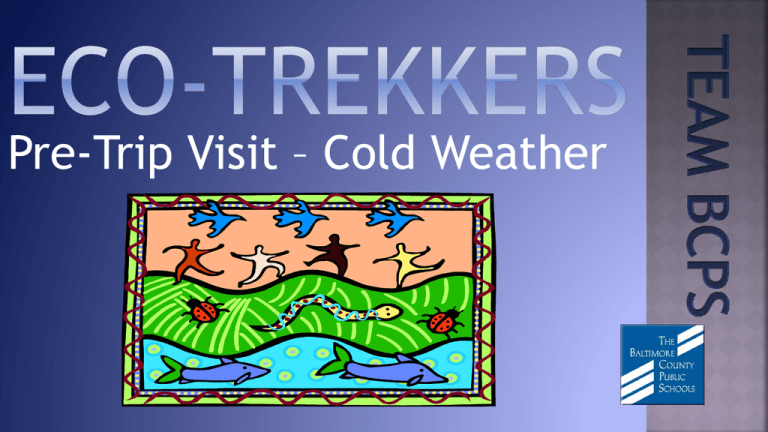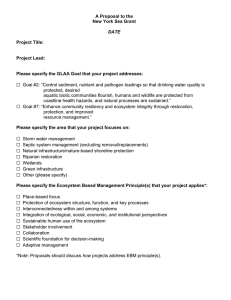Pre-Trip Visit – Cold Weather
advertisement

Pre-Trip Visit – Cold Weather Activities in your school begin four or five days prior to the Eco-Trekker’s field study and will include: • • • • • Producers, consumers, & decomposers. Food chains and food webs. Competition. Predators & prey. Living & non-living factors. Take a brief Pre-assessment Think about how you will make your eco-chamber. Terrestrial Eco-chambers Aquatic Eco-chamber Silversides Green Darner Dragonflies Great Blue Herons White-tailed Deer At your first site, the science resource teacher/naturalist will board the bus, let you know what to bring for the morning, and review the pre-assessment results. Shoreline Wetlands Pass out science logs. Discuss the details of the day. How would you plan and design a model of a successful ecosystem? Scientists collect data. You will record your data in science logs. How do non-living factors affect the living factors in a successful ecosystem? Use four of your senses to identify non-living factors found at the shoreline ecosystem. Thermometers - determine the air temperature and water temperature at the shoreline ecosystem Using a chart of the Chesapeake Bay, predict the salinity of the water of Miami Beach’s shoreline ecosystem. Digital salinity meters - determine the salinity of the water at the shoreline ecosystem Seine net - collect producers, consumers, and evidence of decomposers Record all the data you collected about the living factors into your science log. How do water and decomposed materials move through a successful ecosystem? Use four of your senses to identify non-living factors found at the wetland ecosystem. If students quietly approach the bridge on the boardwalk, it can be an ideal place to observe wetland consumers. Thermometers - determine the air temperature and water temperature at the wetland ecosystem Digital salinity meters - determine the salinity of the water at the wetland ecosystem Dip net - collect producers, consumers, and decomposers Look carefully through the detritus for tiny organisms hiding from predators! Aquatic organisms called macroinvertebrates can often be found in the detritus. Identify common producers found in a wetland ecosystem. Record all the data you collected about the living factors into your science log. At your second site, the science resource teacher/naturalist will board the bus and let you know what to bring for the afternoon. Forest Meadow How does energy from the sun move through a successful ecosystem? Use four of your senses to identify non-living factors found at the forest ecosystem. Thermometers - determine the air temperature at the forest ecosystem Digital salinity meters – discuss the salinity at the forest ecosystem Used by scientists to count and/or measure something within a defined area Using the given flags, identify producers, consumers, and decomposers found in the forest ecosystem. Record all the data you collected about the living factors into your science log. Why is a variety of organisms beneficial to a successful ecosystem? Use four of your senses to identify non-living factors found at the meadow ecosystem. Thermometers - determine the air temperature at the meadow ecosystem Digital salinity meters – discuss the salinity at the meadow ecosystem Sweep net – collect producers, consumers, and decomposers Remove the consumers from the sweep nets. Place them in bug boxes. Observe the consumers and identify them. Count the number of organisms. Record all the data you collected about the living factors into your science log. The field study might be over, but not your role as a scientist! We enter the data you collected online. Use your data to draw conclusions about the different ecosystems. Using what you learned in the classroom and on the field study, you will make an ecochamber. Backpack Plastic bags (2-3) Hand towel Extra clothes: socks, underwear, pants or shorts, shirt Spare shoes/sneakers Rain gear (possibly) Sharpened pencils Trash free lunch Dress in warm layers (which can be taken off as you get warmer). Hat and gloves Appropriate shoes and socks for outside stations (both wet work and dry work) Students will not be entering water when water temperature is below 55˚F or the weather conditions are not appropriate. Dress appropriately! Remember, you will be outdoors at least 4 hours. You must wear shoes if you go in the water and have dry shoes to wear on the bus (no sandals or flip flops). Sunscreen Hat Sunglasses Extra drinking water Dress appropriately! Remember, you will be outdoors at least 4 hours. Acceptable Footwear Footwear with laces Sneakers (preferably old ones) Boots Unacceptable Footwear Open-toed shoes such as: Flip-flops, sandals Teva’s Croc’s No matter what the weather, you will be attending the Eco-Trekker field study. If lightning/thunder develop, we will go indoors. Be prepared for the weather! Trash Free Lunch Reusable lunch bag Reusable water bottle Plastic containers used to hold food Your goal: NOT a Trash Free Lunch Plastic bag for lunch bag Juice box Plastic baggies/Zip-lock baggies used to hold food Lunchables





